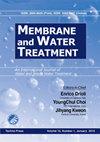Hybrid desalination system of mechanical vapor recompression based on membrane distillation
IF 1.1
4区 工程技术
Q4 ENGINEERING, CHEMICAL
引用次数: 3
Abstract
The microporous PTFE membrane was used for membrane distillation (MD) experiment and presented ultra-high efficiency of desalination. A hybrid desalination system combining membrane distillation and mechanical vapor compression (MD+MVR) had been developed on the basis of the MD experiment. The system featured that the latent heat and part of sensible heat of vapor from the MVR were recovered to heat the MD process, and the heating process occurred in the same module as the MD process. Models were built according to the energy and mass conservation for the system description. Based on the simulation and experimental data, when the system was assigned a treatment capacity 1000 kg h-1 for 1% saline water and with corresponding 875 kg h-1 fresh water production, it would be stuffed with 75.24 m2 of PTFE membrane and expense only 3.31 kW of electrical power, under 353 K of feed temperature in membrane module and 26 kPa of compressor suction pressure. The compressor power requirement would trade off the heat transfer area with variation of the heat transfer temperature difference. The higher the salinity concentration in the residual concentrate after distillation was, the higher the compressor power, membrane area and heat exchanger area would be.基于膜蒸馏的机械蒸汽再压缩混合海水淡化系统
微孔PTFE膜用于膜蒸馏实验,显示出超高的脱盐效率。在MD实验的基础上,开发了膜蒸馏与机械蒸汽压缩相结合的混合脱盐系统(MD+MVR)。该系统的特点是回收MVR蒸汽的潜热和部分显热来加热MD过程,加热过程与MD过程发生在同一模块中。根据系统描述的能量守恒和质量守恒建立了模型。根据模拟和实验数据,当该系统的处理能力为1000 kg h-1,处理1%的盐水,相应的淡水产量为875 kg h-1时,在膜组件中的进料温度为353 K,压缩机吸入压力为26 kPa的情况下,它将填充75.24 m2的PTFE膜,并且仅消耗3.31 kW的电力。压缩机功率需求将权衡传热面积与传热温差的变化。蒸馏后残余浓缩物中的盐度浓度越高,压缩机功率、膜面积和换热器面积就越大。
本文章由计算机程序翻译,如有差异,请以英文原文为准。
求助全文
约1分钟内获得全文
求助全文
来源期刊

Membrane Water Treatment
ENGINEERING, CHEMICAL-WATER RESOURCES
CiteScore
1.90
自引率
30.00%
发文量
0
审稿时长
>12 weeks
期刊介绍:
The Membrane and Water Treatment(MWT), An International Journal, aims at opening an access to the valuable source of technical information and providing an excellent publication channel for the global community of researchers in Membrane and Water Treatment related area. Specific emphasis of the journal may include but not limited to; the engineering and scientific aspects of understanding the basic mechanisms and applying membranes for water and waste water treatment, such as transport phenomena, surface characteristics, fouling, scaling, desalination, membrane bioreactors, water reuse, and system optimization.
 求助内容:
求助内容: 应助结果提醒方式:
应助结果提醒方式:


